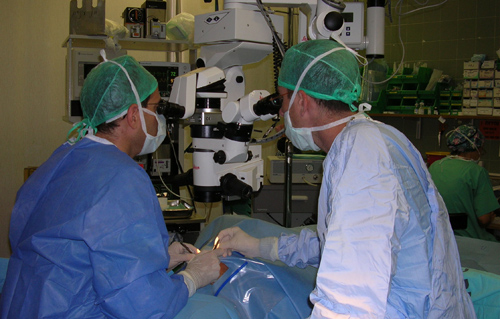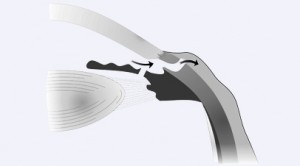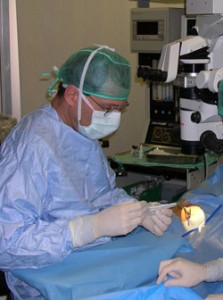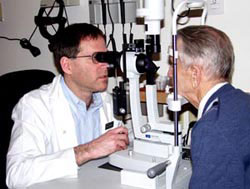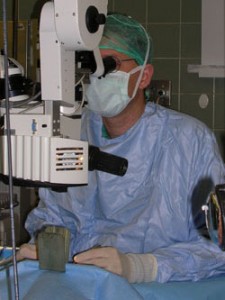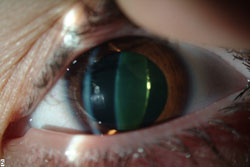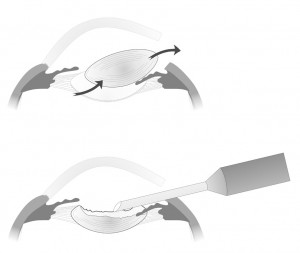 Many patients ask their ophthalmologists if cataract surgery is considered difficult. My answer is: “it depends for whom”. For the surgeon performing the surgery, it is a delicate and precise procedure which requires intense concentration and experience. However, for the patient, the surgery is quite simple. The patient lies on a bed in the operating room and is connected to a heart-rate monitor, receives plenty of oxygen, and has his/her face draped with a special sheet which ensures sterility during the surgery.
Many patients ask their ophthalmologists if cataract surgery is considered difficult. My answer is: “it depends for whom”. For the surgeon performing the surgery, it is a delicate and precise procedure which requires intense concentration and experience. However, for the patient, the surgery is quite simple. The patient lies on a bed in the operating room and is connected to a heart-rate monitor, receives plenty of oxygen, and has his/her face draped with a special sheet which ensures sterility during the surgery.
After the above steps are arranged, local anesthesia is done by instilling eye-drops, much like the drops you receive during routine eye exams, and does not necessitate an injection.
It is important to note that the vast majority of patients will have the surgery under local anesthesia, since the surgery is not associated with significant pain. For these reasons, it is both possible and worthwhile to refrain from the risks and discomfort associated with general anesthesia. Only a very small minority of patients (usually those under the age of 18, particularly infants and children) will undergo surgery under general anesthesia.
Following these numbing drops, the patient does not feel pain or any significant discomfort throughout the procedure. During the course of the surgery the patient sees the light of the microscope, and it is possible that he/she will occasionally feel slight discomfort in the eye. If this occurs, the patient can draw the surgeon’s attention to the situation, and the surgeon will apply additional numbing drops.
The patient can hear the conversation that is taking place between the surgeon, the scrub nurse, and the aids. During the surgery it is possible that the patient will be asked to slightly turn his gaze or his head in a particular direction. It is desirable that the patient won’t move during the surgery; however one need not be concerned about small, involuntary movements, or about blinking, because the ophthalmologist can easily compensate for such minor movements.
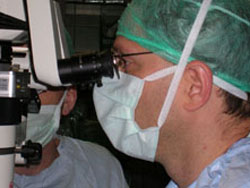 The surgeon begins the procedure by cleaning the eye with a sterile cleaning solution. This solution often stings or burns initially. After confirming that the operating field is clean, the doctor will cover the eye with a sterile, adhesive sheet and prepare the special tools used for eye surgery (these devices are the most delicate surgical equipment in existence). During the course of surgery which is performed under a microscope, the opaque natural lens of the eye will be removed in a controlled fashion, using an instrument which works on ultrasound energy. Many inaccurately refer to this modern ultrasound equipment as cataract performed using a laser.
The surgeon begins the procedure by cleaning the eye with a sterile cleaning solution. This solution often stings or burns initially. After confirming that the operating field is clean, the doctor will cover the eye with a sterile, adhesive sheet and prepare the special tools used for eye surgery (these devices are the most delicate surgical equipment in existence). During the course of surgery which is performed under a microscope, the opaque natural lens of the eye will be removed in a controlled fashion, using an instrument which works on ultrasound energy. Many inaccurately refer to this modern ultrasound equipment as cataract performed using a laser.
After removing the cloudy cataract in its entirety, the surgeon will implant a foldable intra-ocular lens. The ability of this lens to fold upon itself allows the surgeon to insert this lens through a very small incision. At the conclusion of the surgery, the patient will receive antibiotic drops that again, may burn or sting a little, and is brought from the operating room to the recovery room.
After the patient rests for as little as half an hour, or as long as 1-2 hours, he is free to leave the hospital to his/her home, or alternately, only if scheduled in advance, the patient may remain in the hospital overnight.
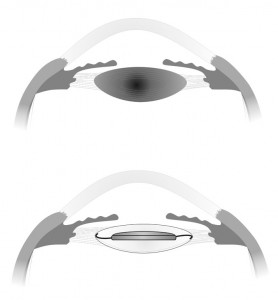 Many patients wonder what they should do and how they should prepare themselves for the surgery in order to increase the chances of its success. The answer is simple: the patient should continue to lead a regular lifestyle including, eating, sleeping, and the like. Regarding medication that patients take for other medical conditions, all medication should be continued as usual.
Many patients wonder what they should do and how they should prepare themselves for the surgery in order to increase the chances of its success. The answer is simple: the patient should continue to lead a regular lifestyle including, eating, sleeping, and the like. Regarding medication that patients take for other medical conditions, all medication should be continued as usual.
After surgery there are patients who are interested in going back to work as early as possible. If the patient has an office job, the doctor is likely to allow the patient to return to work as soon as a few days after surgery. This is not the case with jobs that involve physical exertion or less clean working conditions, such as those found outside of an office, including agriculture and construction. I usually recommend that all patients take a few days of vacation following surgery in order to ensure that you have a chance to rest properly (and also in order to enjoy the company of family and friends).
